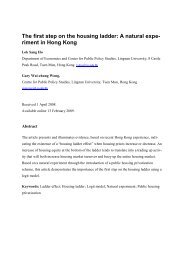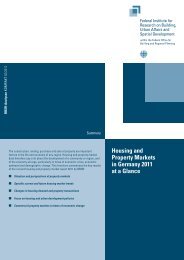housing developments in european countries - Department of ...
housing developments in european countries - Department of ...
housing developments in european countries - Department of ...
You also want an ePaper? Increase the reach of your titles
YUMPU automatically turns print PDFs into web optimized ePapers that Google loves.
Section 2<br />
Context<br />
Context Section 2<br />
2.11 Germany<br />
Table<br />
2.11.1<br />
Characteristics <strong>of</strong> the Hous<strong>in</strong>g Stock<br />
<strong>in</strong> Germany, 2002<br />
Table<br />
2.11.2<br />
Economic Trends <strong>in</strong> Germany, 1995-2001<br />
2.11.1 Policy Mak<strong>in</strong>g and<br />
Implementation<br />
Hous<strong>in</strong>g policy <strong>in</strong> Germany is designed to address<br />
relevant <strong>hous<strong>in</strong>g</strong> market <strong>developments</strong>. At national<br />
level, <strong>hous<strong>in</strong>g</strong> markets are more or less <strong>in</strong> equilibrium.<br />
However, at the same time the balance between<br />
demand and supply varies <strong>in</strong> regional <strong>hous<strong>in</strong>g</strong> markets,<br />
depend<strong>in</strong>g on the level <strong>of</strong> economic dynamism locally<br />
and consequent migratory movements. The situation<br />
calls for <strong>in</strong>creased differentiation <strong>in</strong> the objectives <strong>of</strong><br />
<strong>hous<strong>in</strong>g</strong> policy to address these regional issues.<br />
Another key tenet <strong>of</strong> <strong>hous<strong>in</strong>g</strong> policy <strong>in</strong> Germany is the<br />
promotion <strong>of</strong> owner occupation as an important<br />
component <strong>of</strong> people’s retirement plans, the provision<br />
<strong>of</strong> support to low-<strong>in</strong>come households by means <strong>of</strong><br />
<strong>hous<strong>in</strong>g</strong> benefit and the promotion <strong>of</strong> social <strong>hous<strong>in</strong>g</strong><br />
and co-operative <strong>hous<strong>in</strong>g</strong>.<br />
2.11.2 Stock<br />
In 2002, the <strong>hous<strong>in</strong>g</strong> stock <strong>in</strong> Germany totalled<br />
35,800,000 occupied dwell<strong>in</strong>gs or 434.3 per 1,000<br />
<strong>in</strong>habitants. Of these, 20.6 million (57.7%) were<br />
rented and 15.1 million (43.2%) were owner-occupied.<br />
6% <strong>of</strong> dwell<strong>in</strong>gs were rented from social landlords.<br />
The number <strong>of</strong> owner-occupier households <strong>in</strong> the<br />
country has risen by 1.7% s<strong>in</strong>ce 1998, although the<br />
German home ownership rate rema<strong>in</strong>s the lowest <strong>of</strong><br />
the 28 <strong>countries</strong> under exam<strong>in</strong>ation. The <strong>in</strong>crease <strong>in</strong><br />
owner occupation has been larger <strong>in</strong> the regions with<strong>in</strong><br />
the former German Democratic Republic (GDR). Thus,<br />
while the level <strong>of</strong> owner occupation is approximately<br />
10% higher <strong>in</strong> Western Germany as compared to the<br />
east, <strong>in</strong> the latter region the number <strong>of</strong> young<br />
households enter<strong>in</strong>g the owner-occupier <strong>hous<strong>in</strong>g</strong><br />
market has moved closer to the average for Western<br />
Germany <strong>in</strong> recent years.<br />
TABLE 2.11.1 sketches the key characteristics <strong>of</strong> the<br />
German <strong>hous<strong>in</strong>g</strong> stock. It reveals that compared to<br />
many other European <strong>countries</strong> the German <strong>hous<strong>in</strong>g</strong><br />
Category %<br />
Dwell<strong>in</strong>gs by size < 40m 2 4.7<br />
40-60 m 2 17.9<br />
60-80 m 2 25.4<br />
80-100 m 2 17.6<br />
> 100 m 2 34.4<br />
Dwell<strong>in</strong>gs by period<br />
<strong>of</strong> construction < 1949 27.9<br />
1949-1978 46.9<br />
1979-1986 10.9<br />
1987-1990 3.2<br />
> 1990 11.1<br />
stock is comparatively young – 25% <strong>of</strong> all dwell<strong>in</strong>gs<br />
have been built s<strong>in</strong>ce 1979. In addition, <strong>in</strong> terms <strong>of</strong><br />
floor space German dwell<strong>in</strong>gs are relatively generously<br />
sized – 77% are larger than 60 m 2 <strong>in</strong> size.<br />
Vacancy rates vary quite considerably from region to<br />
region <strong>in</strong> Germany. Until recently, <strong>in</strong> western Germany<br />
<strong>hous<strong>in</strong>g</strong> vacancies have generally been a temporary<br />
phenomenon. However, <strong>in</strong> some regions with<strong>in</strong> the<br />
former GDR a decrease <strong>in</strong> population has created a<br />
problem <strong>of</strong> redundant <strong>hous<strong>in</strong>g</strong>. In these areas there is<br />
an excess supply <strong>of</strong> vacant dwell<strong>in</strong>gs, amount<strong>in</strong>g to<br />
more than 1.1 million dwell<strong>in</strong>gs, for which there will<br />
be no demand <strong>in</strong> the foreseeable future. This has <strong>in</strong><br />
turn underm<strong>in</strong>ed local rental markets and created<br />
problems <strong>of</strong> urban decl<strong>in</strong>e. Although this phenomenon<br />
is a limited problem, it is be<strong>in</strong>g closely monitored by<br />
central and regional government.<br />
2.11.3 Economy<br />
Details <strong>of</strong> recent economic trends <strong>in</strong> Germany are set<br />
out <strong>in</strong> TABLE 2.11.2. which shows that the rate <strong>of</strong><br />
growth <strong>in</strong> GDP <strong>in</strong> this country has fallen <strong>in</strong> recent<br />
years – from 1.7% <strong>in</strong> 1995 to 0.8% <strong>in</strong> 2001. At the<br />
same time <strong>in</strong>flation has <strong>in</strong>creased marg<strong>in</strong>ally – from<br />
1.2% <strong>in</strong> 1996 to 1.9% <strong>in</strong> 2001. But unemployment<br />
has fallen from 8.0% <strong>of</strong> the labour force <strong>in</strong> 1995 to<br />
7.8% <strong>in</strong> 2001.<br />
Category 1995 1996 1997 1998 1999 2000 2001<br />
% % % % % % %<br />
Change <strong>in</strong> GDP at current prices (%) 1.7 0.8 1.4 2.0 2.0 2.9 0.8<br />
Unemployed persons as a % <strong>of</strong> the labour force 8.0 8.7 9.7 9.1 8.4 7.8 7.8<br />
Change <strong>in</strong> the consumer price <strong>in</strong>dex (%) Nav 1.2 1.5 0.6 0.6 1.4 1.9<br />
2.11.4 Demography<br />
Table<br />
2.11.3<br />
In 2002, the population <strong>of</strong> Germany totalled<br />
82,537,000 persons. The German population has<br />
<strong>in</strong>creased slightly s<strong>in</strong>ce 1992 when it stood at<br />
80,274,600 persons. TABLE 2.11.3 demonstrates that<br />
this population <strong>in</strong>crease is the result <strong>of</strong> net migration<br />
rather than natural <strong>in</strong>crease, as the birth rate <strong>in</strong><br />
Germany has been consistently low s<strong>in</strong>ce the 1970s.<br />
Indeed, as a result <strong>of</strong> the low birth rate, the population<br />
is projected to decl<strong>in</strong>e significantly after 2020. The<br />
extent <strong>of</strong> the decrease will be largely determ<strong>in</strong>ed by the<br />
level <strong>of</strong> immigration to Germany. However, estimates<br />
suggest that the population will decrease to just below<br />
70 million by the year 2050, or by some 15%<br />
compared to the current population.<br />
TABLE 2.11.3 also demonstrates that these low birth<br />
rates have also contributed to the age<strong>in</strong>g <strong>of</strong> the<br />
Demographic Trends <strong>in</strong> Germany, 1992-2000<br />
German population structure. Forecasts suggest that<br />
between now and the year 2050 the ratio <strong>of</strong> the over-<br />
60s to the 20-60 year age group will approximately<br />
double. In 2001 there were 100 persons <strong>of</strong> work<strong>in</strong>g<br />
age <strong>in</strong> Germany for every 44 persons <strong>of</strong> pensionable<br />
age. The latter figure will rise to 54 by the year 2020,<br />
while the elderly dependency ratio is expected to rise<br />
to 75 by the year 2050.<br />
In 2002, there were 38,720,000 households <strong>in</strong><br />
Germany. The average household size <strong>in</strong> this country<br />
has rema<strong>in</strong>ed stable s<strong>in</strong>ce 1992, at 2.2 persons.<br />
However, between now and the year 2020 the average<br />
size <strong>of</strong> German households is projected to fall further<br />
due to <strong>in</strong>creas<strong>in</strong>g numbers <strong>of</strong> 1 and 2 person<br />
households and as a consequence the number <strong>of</strong><br />
households is set to <strong>in</strong>crease.<br />
Category 1992 1994 1996 1998 2000<br />
Population by age group (%) 0-14 years 16.3 16.4 16.2 16.0 15.7<br />
15-24 years 12.8 11.8 11.2 11.0 11.1<br />
25-49 years 36.6 37.4 38.1 38.4 38.0<br />
50-64 years 19.3 19.3 18.9 18.8 19.0<br />
65-79 years 9.3 10.0 10.7 11.5 12.3<br />
> 80 years 3.8 4.0 4.0 3.7 3.6<br />
Population change<br />
(per 1,000 population) Net migration 9.6 3.9 3.4 0.6 2.0<br />
National population change –0.9 –1.4 –1.1 –0.8 –0.9<br />
Average number <strong>of</strong> persons per private households 2.2 2.2 2.2 2.2 2.2<br />
42 European Union Report<br />
Regular National Report on Hous<strong>in</strong>g Developments <strong>in</strong> European Countries<br />
43

















